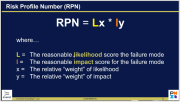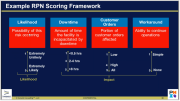Written by: Catherine Binuya, Ed.D.
Presentation Overview 
Steve Hopper, founder and principal of Inviscid Consulting, is a subject matter expert and specialist in supply chain operations, warehousing, logistics, and distribution. He answered the questions: what are risks? what can go wrong? and how do we deal with it? He then shared several analytical models to quantify, rank and subsequently mitigate risk.
Takeaways
- FMEA—Failure Mode & Effects Analysis is an objective, systematic, iterative approach to manage and prioritize potential failure modes to mitigate impact. Initially developed by the US military in 1949, with applications in aerospace by NASA and later the automotive industry
- Note: FMECA—Failure Mode & Effects Criticality Analysis applies probability and statistics to assess FMEA mitigation
- FMEA approach can either be
- Top-Down—if focus is on operation and/or design
- Bottom-Up—if focus is on product design
- Anatomy of Operational Risk—Two measures of failure
- Likelihood: measures realistic possibility of failure (3 levers)
- Occurrence
- Resulting Harm
- Non-detection
- Impact: measures realistic consequences if failure occurs (3 targets)
- Functional Operation
- Time (downtime)
- Customers’ ability to process services or goods
- Likelihood: measures realistic possibility of failure (3 levers)
- Identifying Risk Controls (2 types)
- Preventative Controls—attempt to filter causal factors to lower or eliminate likelihood of failure
- Preparedness Controls—attempt to filter failure to lower or eliminate impact
- RPN—Risk Profile Number: assign each identified risk an objective, composite score calculation based on measure of likelihood and impact.
Next Event
Join us at the next PMI Atlanta Architectural, Engineering, & Construction (AEC) Forum on November 8, 2022
Register at www.pmiatlanta.org/events/event-calendar



